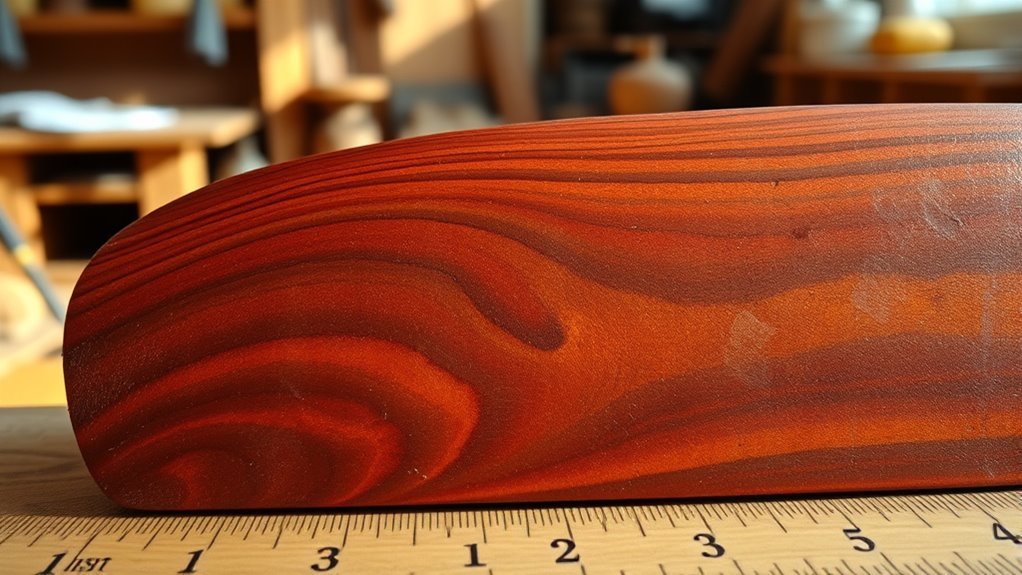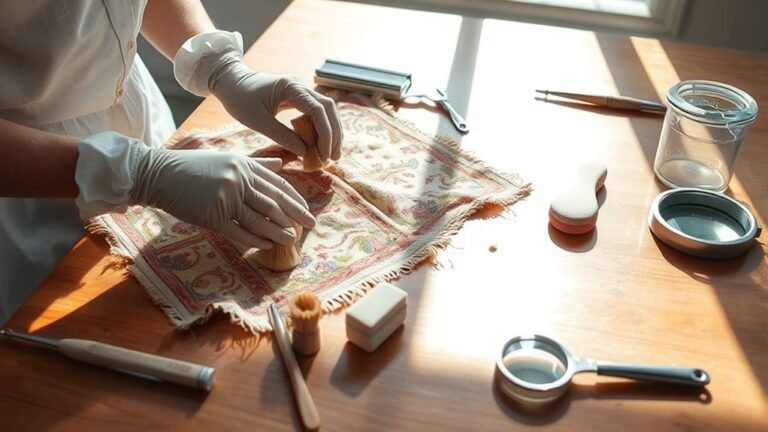Review of Top-Rated Wood
If you’re choosing top-rated wood, expect exceptional strength, durability, and stability across options like oak, maple, teak, mahogany, and cherry. Oak offers dense grain and natural resistance to wear; maple provides moisture resistance and mechanical strength; teak excels outdoors with natural oils and decay resistance; mahogany delivers workability and decay prevention; cherry boasts fine grain and rich color. These woods suit furniture, flooring, and cabinetry with minimal maintenance. Explore further to uncover detailed features and best uses.
Characteristics of Oak Wood
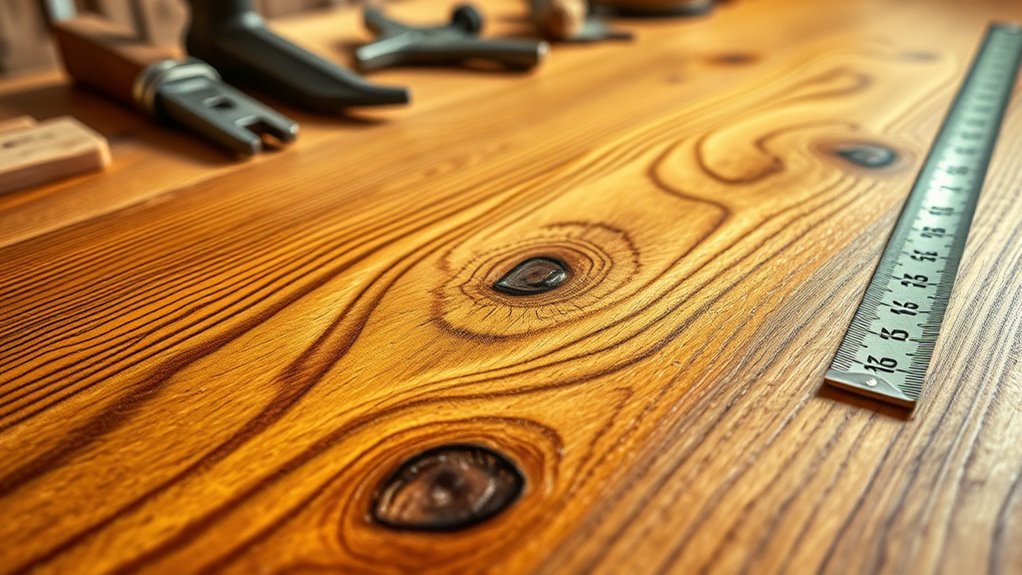
Oak wood stands out for its exceptional strength and durability, making it a preferred choice in furniture and flooring. When you select oak wood, you benefit from its dense grain structure, which enhances resistance to wear and impact. Oak characteristics include high hardness, measured between 1,200 and 1,360 on the Janka scale, ensuring longevity under heavy use. Its coarse texture and prominent grain patterns offer both aesthetic appeal and structural integrity. Additionally, oak wood exhibits excellent dimensional stability, reducing warping risks in varying humidity. You’ll appreciate its natural tannins, providing resistance against fungal attacks and insect damage. Whether for crafted furniture or robust flooring, oak wood’s reliable performance aligns with your desire for durable, long-lasting materials that support freedom in design and function.
Benefits of Maple Wood
You’ll find maple wood offers exceptional durability and strength, making it ideal for both structural and decorative uses. Its fine, uniform grain provides a smooth surface that enhances aesthetic appeal in furniture and flooring. Understanding these benefits will help you determine if maple suits your project’s requirements.
Durability and Strength
Durability is a key factor when choosing wood for long-lasting projects, and maple excels in this area due to its exceptional hardness and strength. Its Janka hardness rating consistently ranks high, making it resistant to dents and wear. When you apply proper wood treatment, maple’s cellular structure enhances its natural resistance to moisture, reducing the risk of warping or swelling. This moisture resistance guarantees stability in varying environmental conditions, critical for both indoor and outdoor applications. Maple’s dense grain also contributes to its mechanical strength, allowing it to withstand heavy loads without compromising integrity. By selecting maple, you’re choosing a wood that combines robustness with reliable performance, giving you the freedom to create durable, enduring structures and furniture that stand the test of time with minimal maintenance.
Aesthetic Appeal
Maple wood offers several distinct aesthetic benefits that make it a preferred choice for fine woodworking and design. You’ll appreciate its smooth, consistent grain, which highlights the wood’s natural beauty without overwhelming the overall look. This clarity allows you to customize finishes—from clear coats that enhance its pale, creamy color to stains that deepen its tone—all while preserving the wood’s inherent elegance. Maple’s design versatility lets you adapt it easily to modern or traditional settings, providing a clean, sophisticated appearance whether used in cabinetry, flooring, or furniture. Its fine texture also accepts intricate carving and shaping, giving you freedom to realize detailed designs with precision. Choosing maple means embracing both function and form, ensuring your projects stand out with lasting visual appeal.
Features of Teak Wood
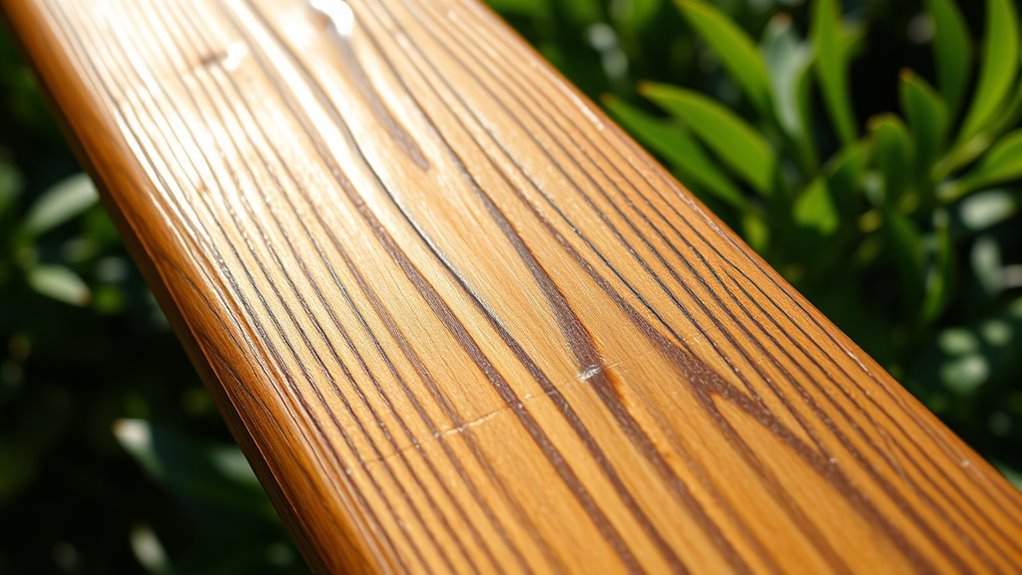
Although teak wood is often prized for its rich golden-brown color, its true value lies in its exceptional density and natural oils, which provide superior resistance to water, pests, and decay. When you choose teak, you’re selecting a wood with outstanding durability and structural stability, making it ideal for outdoor and marine applications. Teak sustainability has improved with responsible plantations, guaranteeing supply without compromising natural forests. You’ll also appreciate that teak maintenance is minimal; its natural oils reduce the need for frequent sealing or treatment, allowing more freedom from upkeep. Its fine grain and dimensional stability assure it won’t warp or crack easily, giving you long-lasting performance. These features make teak an excellent choice if you prioritize resilience combined with eco-conscious sourcing.
Advantages of Mahogany Wood
When you select mahogany wood, you’re opting for a material renowned for its exceptional workability and consistent grain structure, which allows for precise machining and smooth finishes. Its dimensional stability minimizes warping and swelling, granting you freedom from frequent adjustments. Mahogany’s natural resistance to decay and insect damage extends longevity, reducing the need for intensive maintenance. By choosing mahogany sourced through responsible sustainability practices, you support forest conservation and ethical harvesting. To maintain its rich appearance, follow simple maintenance tips: clean with a soft cloth, avoid harsh chemicals, and apply appropriate finishes periodically. This combination of durability, ease of care, and environmental responsibility makes mahogany a superior choice for projects where lasting quality and efficiency matter.
Uses of Cherry Wood
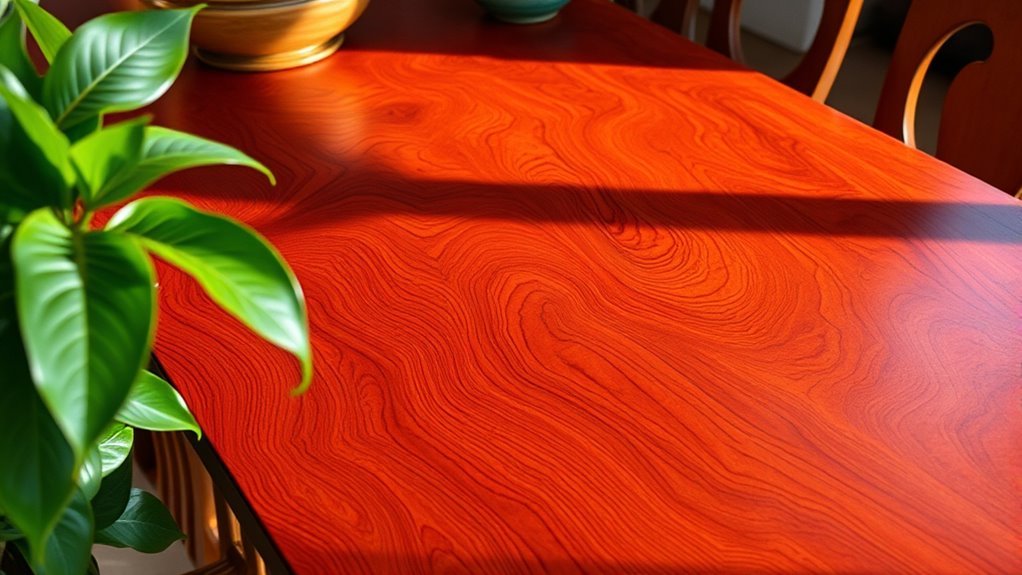
You’ll find cherry wood is highly valued for furniture and cabinetry due to its fine grain and smooth finish. Its durability and rich color also make it a preferred choice for flooring and detailed woodwork. Understanding these applications will help you appreciate its versatility in woodworking projects.
Furniture and Cabinetry
Cherry wood is prized in furniture and cabinetry for its fine grain, rich color, and exceptional workability. When you choose cherry, you’re opting for a wood that responds well to detailed machining and carving, allowing precise joinery and smooth surfaces. Its uniform texture supports superior wood finishing, resulting in pieces that age gracefully with a deep, warm patina. Beyond aesthetics, selecting cherry harvested under rigorous sustainability practices guarantees your furniture is eco-conscious without compromising quality. Whether crafting cabinets or custom furniture, cherry’s dimensional stability minimizes warping, giving you durable, long-lasting results. This balance of beauty, workability, and responsible sourcing makes cherry wood an ideal choice for those seeking freedom in design and function without sacrificing environmental stewardship.
Flooring and Woodwork
Beyond furniture and cabinetry, cherry wood’s properties make it highly suitable for flooring and intricate woodwork. Its fine grain and natural luster provide a smooth, warm surface that enhances any space. If you’re considering cherry wood for flooring, verify it comes from sustainable sourcing to support eco-friendly practices. Cherry’s moderate hardness balances durability with ease of machining, allowing detailed carvings and moldings without compromising structural integrity. To maintain its rich color and prevent wear, apply proper maintenance tips such as using protective finishes and avoiding excessive moisture. With correct care, cherry wood flooring and woodwork age gracefully, developing a unique patina that reflects your personal style. Choosing cherry wood empowers you to create lasting, elegant interiors with environmental responsibility.
Durability of Walnut Wood
Although walnut wood is celebrated for its rich color and grain, its durability is equally impressive, making it a preferred choice for many applications. You’ll find that walnut grain structure contributes considerably to its strength and resistance to wear. When properly treated with quality walnut finishes, its resilience against moisture and abrasions increases, extending its lifespan.
Consider these key durability features of walnut wood:
Explore walnut wood’s durability through its density, hardness, stability, decay resistance, and finish compatibility.
- High density guarantees robust structural integrity
- Moderate hardness resists dents and scratches well
- Excellent dimensional stability minimizes warping
- Natural resistance to decay and fungal attacks
- Compatibility with various finishes enhances protection
With these characteristics, walnut wood offers you both aesthetic appeal and long-lasting performance, granting freedom to use it confidently in furniture, flooring, or cabinetry.
Frequently Asked Questions
How to Properly Store Wood to Prevent Warping?
To properly store wood and prevent warping, you need to maintain consistent humidity control and temperature regulation. Store wood in a well-ventilated area, away from direct sunlight and moisture. Use a dehumidifier if necessary to keep humidity levels stable, ideally between 30-50%. Avoid rapid temperature fluctuations, as they cause wood to expand and contract unevenly. Stack wood flat with spacers to promote air circulation, ensuring it stays straight and stable over time.
What Is the Best Finish for Outdoor Wood Furniture?
For outdoor wood furniture, you’ll want oil finishes that penetrate deeply, enhancing durability while preserving natural grain. These finishes offer excellent UV protection, essential for preventing sun damage and fading. Look for formulations combining tung or linseed oil with added UV inhibitors for ideal defense. Applying multiple coats guarantees a resilient, water-resistant barrier, letting your furniture withstand weather while maintaining a rich, natural appearance—perfect if you value both protection and freedom in outdoor settings.
Are These Woods Sustainable and Eco-Friendly?
You might think all wood is sustainable, but its eco-friendliness depends on sustainable sourcing practices and eco-friendly certifications like FSC or PEFC. When choosing wood, make certain it’s harvested responsibly to protect forests and biodiversity. By verifying these certifications, you’re not just selecting quality material—you’re supporting environmental freedom and responsible stewardship. This approach guarantees your wood furniture aligns with both durability and ecological integrity, letting you enjoy nature without compromise.
How Do Wood Prices Compare Among These Types?
When comparing wood prices, you’ll notice significant price fluctuations influenced by market trends like supply shortages and demand spikes. Hardwoods generally cost more due to slower growth rates, while softwoods fluctuate less. Keeping an eye on these trends helps you anticipate costs and make informed choices. If you value freedom in your projects, understanding these dynamics lets you optimize budgets without sacrificing quality or sustainability.
Can These Woods Be Easily Recycled or Repurposed?
Oh, sure—because who doesn’t dream of turning old wood into avant-garde furniture or eco-friendly art? You’ll find these woods offer versatile recycling methods, from shredding for mulch to chemical-free treatments for reuse. Repurposing ideas include crafting durable flooring or rustic décor, giving you freedom to innovate sustainably. Just remember, the wood’s density and finish affect recyclability, so choose wisely to maximize your eco-friendly, creative exploits.
